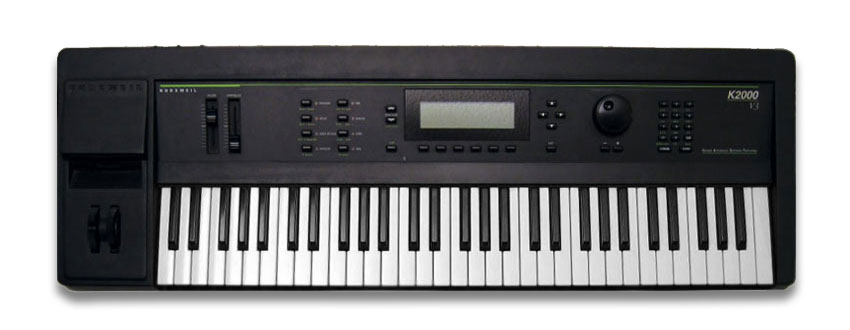KURZWEIL K2000 - When Polyphony Meets Intelligence

At the beginning of the 1990s, the music world found itself at a crossroads between analog tradition and the digital future. While analog synthesizers provided a warm, organic sound, digital technology promised infinite possibilities for modification and precise control over every parameter.
In 1991, the Kurzweil K2000 entered the scene – an instrument that combined the best of both worlds and introduced a revolutionary approach to sound synthesis.
History and Development of Kurzweil K2000
The development of the K2000 was led by Ray Kurzweil, a visionary in musical technology renowned for his advancements in sampling systems. His goal was to create a synthesizer that would not only realistically emulate acoustic instruments but also provide musicians unlimited freedom in sound creation.
The result was V.A.S.T. (Variable Architecture Synthesis Technology) – a system that allowed users to define custom signal paths and combine various DSP processes.
Technological Innovations – What Makes the K2000 Exceptional?
The Kurzweil K2000 was not just another digital synthesizer. It featured 24-voice polyphony, advanced multi-mode filters and cutting-edge sampling capabilities. Thanks to V.A.S.T., users could edit sounds at a level previously available only in modular analog systems.
Detailed Analysis of V.A.S.T. Synthesis
The Kurzweil K2000 introduced V.A.S.T., allowing users to customize the sound processing path with unprecedented flexibility. Unlike conventional digital synthesizers with fixed oscillator, filter, and effect structures, V.A.S.T. allowed custom combinations of DSP processes, opening doors to completely unique sound synthesis.
How Does V.A.S.T. Work?
V.A.S.T. operates on the principle of modular chaining of DSP blocks, allowing users to choose how the sound is processed. Each sound program in the K2000 can contain up to three oscillators, which can be combined with various algorithms for signal processing. The key possibilities include:
• Resonant filters – enabling fine shaping of the frequency spectrum.
• Amplitude modulation – adding dynamics and movement to the sound.
• Crossfade and waveshaping – allowing smooth transitions between different sound characteristics.
• Oscillator sync – analog oscillator sync emulations.
• Digital distortion – providing extensive tone-shaping capabilities.
Modulation and Parameter Control
One of V.A.S.T.'s greatest advantages is its comprehensive modulation system, enabling users to link multiple control sources to sound parameters. This approach resembles analog modular synthesizers, but with digital precision and the ability to store presets.
Flexibility in Signal Routing
V.A.S.T. allows for custom-defined signal paths, meaning sound can be processed in different ways based on the selected algorithm. Thanks to this flexibility, the K2000 became a favorite instrument for both traditional music production and experimental sound design.
Digital Oscillators and Internal PCM samples
The K2000 was equipped with digital oscillators that emulated standard analog waveforms (sine, saw and square). The basic equipment of the instrument also included an internal 8 MB ROM board, containing a wide variety of samples, from classic analog waveforms to highly realistic orchestral sounds.
Filters and Modulation
One of the key aspects of the K2000 was its multi-mode digital filters, offering extensive frequency shaping options. Filters could be modulated via LFO or envelopes, allowing dynamic real-time changes.
Effects and Signal Processing
The K2000 featured a relatively powerful effect processor (based on Digitech 256 chip) at this time, expanding sound design possibilities. Its most important effects included:
• Reverb
• Delay
• Chorus
• Flanger
These effects could be used both individually and in preset combinations and were particularly useful for live performances, allowing for quick adjustments without external processors.
Integration into Studio Environments
The K2000 was designed for seamless integration with studio instruments and DAW software via MIDI interface.
Comparison with Other Synthesizers of Its Time
Kurzweil K2000 vs. Roland JD-800
The Roland JD-800 was well-known for its hands-on approach – it featured numerous physical sliders that allowed immediate manipulation of sound. However, unlike the K2000, the JD-800 used a fixed structure, meaning it had less flexibility in sound synthesis. While the K2000 provided deeper modulation options, the JD-800 excelled in live performance control.
Kurzweil K2000 vs. Korg M1
The Korg M1 was one of the best-selling synthesizers at this time, which despite its somewhat limited to filtering and envelope, offered universal use in many musical genres (e.g. its PCM preset "Piano 16" later became a literally cult among House music style producers). The Kurzweil K2000, however, offered perfect orchestral instrument emulations and fully modular synthesis, making it superior for electronic, film and experimental music production.
Kurzweil K2000 vs. Yamaha SY99
The Yamaha SY99 was one of the most advanced FM synthesizers, combining FM synthesis with PCM sampling. The SY99 had deeper FM capabilities, but the K2000 offered greater flexibility in signal routing due to its V.A.S.T. technology.
Hardware Expansions
Kurzweil K2000 can be upgraded using various hardware expansions, such as:
• Orchestral and Contemprary ROM boards – adds new PCM ROM samples and factory sound
programs.
• P-RAM memory – increases capacity for storing custom sounds.
• Sample RAM memory – for external samples.
• Sample Option Board – for creating user samples
User Modifications
• Replacing the floppy drive with a USB emulator – enables easier storage and loading of presets.
Cultural Impact of Kurzweil K2000
The K2000 became an essential instrument for artists such as:
• Stevie Wonder
• Herbie Hancock
• Jean-Michel Jarre
• Nine Inch Nails
• Peter Gabriel
• Aphex Twin
• Trent Reznor
• Autechre
• Squarepusher
Conclusion
The Kurzweil K2000 is a timeless synthesizer, defining the era of digital synthesis. Even today, it remains a source of inspiration for musicians and producers.
| |
|
|
|
|
|
|
|
|


